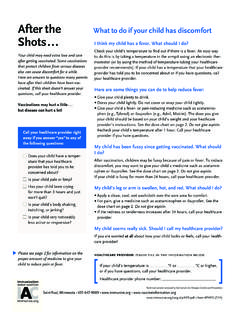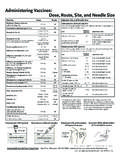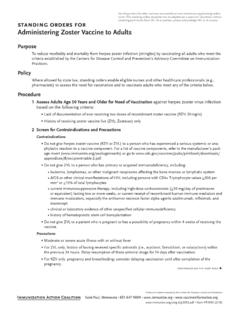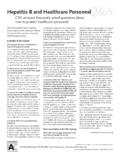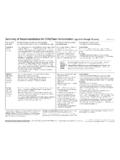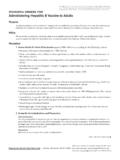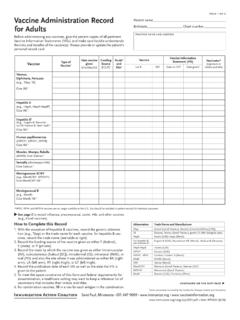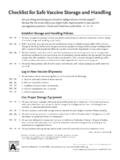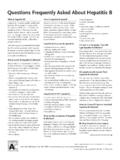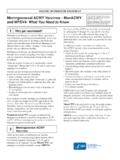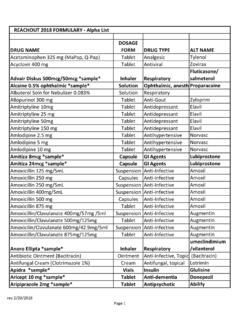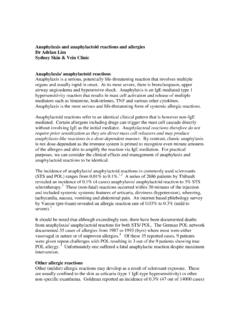Transcription of Medical Management of Vaccine Reactions in …
1 ManagementApply a cold compress to the injection site. Consider giving an analgesic (pain reliever) or antipruritic (anti-itch) an adhesive compress over the injection thick layer of gauze pads over site and maintain direct and firm pressure; raise the bleed-ing injection site ( , arm) above the level of the patient s patient sit or lie down for the patient lie flat or sit with head between knees for several minutes. Loosen any tight clothing and maintain an open airway. Apply cool, damp cloths to patient s face and the patient to determine if injury is present before attempting to move the patient. Place patient flat on back with feet the patient to determine if injury is pres-ent before attempting to move the patient.
2 Place patient flat on back with feet elevated. Call 911 if patient does not recover Emergency Medical Protocol for Manage - ment of Anaphylactic Reactions in Children and Teens on the next page for detailed steps to follow in treating anaphylaxis. continued on next page Medical Management of Vaccine Reactions in Children and TeensreactionLocalized Psychological fright and syncope (fainting) AnaphylaxissymptomsSoreness, redness, itching, or swelling at the injection site Slight bleedingContinuous bleeding Fright before injection is givenExtreme paleness, sweating, coldness of the hands and feet, nausea, light-headedness, dizziness, weakness, or visual disturbancesFall, without loss of consciousness Loss of consciousness Sudden or gradual onset of generalized itching, erythema (redness), or urti caria (hives); angioedema (swelling of the lips, face, or throat).
3 Severe broncho spasm (wheezing); shortness of breath; shock; abdominal cramping; or cardio-vascular collapseAll vaccines have the potential to cause an adverse reaction. In order to minimize adverse Reactions , patients should be carefully screened for precautions and contraindications before Vaccine is administered (see ). Even with careful screening, Reactions may occur. These Reactions can vary from trivial and inconvenient ( , soreness, itching) to severe and life threatening ( , anaphy-laxis). Vaccine providers should be familiar with identifying immediate-type allergic Reactions , including anaphylaxis, and be competent in treating these events at the time of Vaccine administration.
4 Providers should also have a plan in place to contact emergency Medical services immediately in the event of a severe acute Vaccine reaction. Maintenance of the airway, oxygen administration, and intravenous normal saline might be necessary. The table below describes procedures to follow if various Reactions Action Coalition Saint Paul, Minnesota 651-647-9009 content reviewed by the Centers for Disease Control and Item #P3082a (7/16)Emergency Medical protocol for Management of anaphylactic Reactions in children and teens1 If itching and swelling are confined to the injection site where the vaccination was given, observe patient closely for the development of generalized If symptoms are generalized, activate the emergency Medical system (EMS; , call 911) and notify patient s physician.
5 This should be done by a sec-ond person, while the primary healthcare professional assesses the airway, breathing, circulation, and level of consciousness of the patient. Vital signs should be monitored drug dosing information: The first-line and most important therapy in anaphylaxis is epinephrine. There are NO contraindications to epinephrine in the setting of anaphylaxis. a First-line treatment: Administer aqueous epinephrine 1:1000 dilution ( , 1 mg/mL) intramuscularly; the standard dose is mg/kg body weight, up to mg maximum single dose in children and adolescents. See dosing chart on page 3. b Optional treatment: H antihistamines for hives or itching, you may also administer diphenhydramine (either orally or by intramuscular injection; the standard dose is 1 2 mg/kg body weight, up to 50 mg maximum dose in children and adolescents*) or hydroxyzine (orally; the standard dose is 1 mg/kg/dose up to 50 100 mg maximum per day in children and adolescents).
6 See dosing charts on page 3.*According to AAP s Red Book, for children age 12 years, the diphenhydramine maximum single dose is 100 Monitor the patient closely until EMS arrives. Perform cardiopulmonary resuscitation (CPR), if necessary, and maintain airway. Keep patient in supine position (flat on back) unless he or she is having breathing difficulty. If breathing is difficult, patient s head may be elevated, provided blood pres-sure is adequate to prevent loss of consciousness. If blood pressure is low, elevate legs. Monitor blood pressure and pulse every 5 If EMS has not arrived and symptoms are still present, repeat dose of epinephrine every 5 15 minutes for up to 3 doses, depending on patient s Record the adverse event ( , hives, anaphylaxis) to the Vaccine , all vital signs, medications administered to the patient, including the time, dosage, response, and the name of the Medical personnel who administered the medication, and other relevant clinical information.
7 Report the incident to the Vaccine Adverse Event Reporting System (VAERS).7 Notify the patient s primary care Management of Vaccine Reactions in Children and Teens (continued) page 2 of 3 Needed medications for a community immunization clinicfirst-line medicationEpinephrine, aqueous 1:1000 dilution, in ampules, vials of solution, or prefilled syringes, including epinephrine auto-injectors ( , EpiPen and Auvi-Q). If autoinjectors are stocked, at least three should be available (both pediatric and adult formulations).Optional medication: H antihistaminesDiphenhydramine ( , Benadryl) oral ( mg/5 mL liquid, 25 or 50 mg capsules/tablets) or injectable (50 mg/mL solution).
8 Hydroxyzine ( , Atarax, Vistaril) oral (10 mg/5 mL or 25 mg/5 mL liquid, 10 mg or 25 mg tablets, or 25 mg capsules).Suggested supplies for a community immunization clinicSyringes (1 and 3 cc) and needles (22 and 25 g, 1", 1 ", and 2") for epinephrine, diphenhydramine, or hydroxyzine. For ampules, use filtered wipesTourniquet*Pediatric and adult airways (small, medium, and large)Pediatric and adult size pocket masks with one-way valveOxygen (if available)StethoscopeSphygmomanometer (blood pressure measuring device) with child, adult, and extra large cuffsTongue depressorsFlashlight with extra batteries (for exam ination of the mouth and throat)Wristwatch with a second hand or other timing deviceCell phone or access to onsite phone* Applied on the extremity above the injection site to slow systemic absorption of antigen and anaphylactic on next page These standing orders for the Medical Management of Vaccine Reactions in child and teenage patients shall remain in effect for patients of the name of clinic until rescinded or until date Medical director s signature date of signingImmunization Action Coalition
9 Saint Paul, Minnesota 651-647-9009 Item #P3082a (7/16) Medical Management of Vaccine Reactions in Children and Teens (continued) page 3 of 31 6 months 9 19 lb 4 kg mL (or mg) off label7 36 months 20 32 lb 9 kg mL (or mg) off label37 59 months 33 39 lb 15 kg mL (or mg) mg/dose5 7 years 40 56 lb 18 kg mL (or mg) mg/dose8 10 years 57 76 lb 26 kg mL (or mg) mg or mg/dose11 12 years 77 99 lb 35 45 kg mL (or mg) mg/dose13 years & older 100+ lb 46+ kg mL (or mg) max. dose mg/dosenote: If body weight is known, then dosing by weight is preferred. If weight is not known or not readily available, dosing by age is appropriate. Recommended dose is mg/kg body weight up to mg maximum dose.
10 May be repeated every 5 15 minutes for a total of 3 and childrenTeensAge groupRange of weight (lb)Range of weight (kg)*Epinephrine Dose1 mg/mL injectable (1:1000 dilution); intramuscularMinimum dose: mLEpinephrine auto-injector, mg or mg First-Line Treatment: EpinephrineFor your convenience, approximate dosages based on weight and age are provided in the following charts. Please confirm that you are administering the correct dose for your patient. * Rounded weight at the 50th percentile for each age range* Rounded weight at the 50th percentile for each age range7 36 months 20 32 lb 9 kg 5 mg/dose37 59 months 33 39 lb 15 kg 10 mg/dose5 7 years 40 56 lb 18 kg 10 mg/dose8 10 years 57 76 lb 26 kg 15 mg/dose11 12 years 77 99 lb 35 45 kg 15 25 mg/dose13 years & older 100+ lb 46+ kg 25 mg/dose (50 100 mg, maximum per day)note: If body weight is known, then dosing by weight is preferred.
